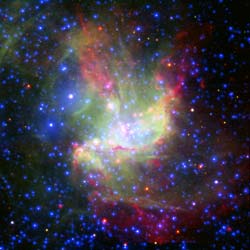Born from the Wind – Unique Multi-wavelength Portrait of Star Birth

This new portrait of the bright star-forming region NGC 346, in which different wavelengths of light swirl together like watercolours, reveals new information about how stars form. NGC 346 is located 210 000 light-years away in the Small Magellanic Cloud, a neighbouring dwarf galaxy of the Milky Way. The image is based on data from ESA XMM-Newton (X-rays; blue), ESO\'s New Technology Telescope (visible light; green), and NASA\'s Spitzer (infrared; red). The infrared light shows cold dust, while the visible light denotes glowing gas, and the X-rays represent very hot gas. Ordinary stars appear as blue spots with white centres, while young stars enshrouded in dust appear as red spots with white centres. Credit: ESO/ESA/JPL-Caltech/NASA/D. Gouliermis (MPIA) et al.
The picture combines infrared, visible and X-ray light from NASA's Spitzer Space Telescope, ESO's New Technology Telescope (NTT) and the European Space Agency's XMM-Newton orbiting X-ray telescope, respectively. The NTT visible-light images allowed astronomers to uncover glowing gas in the region and the multi-wavelength image reveals new insights that appear only thanks to this unusual combination of information.
NGC 346 is the brightest star-forming region in the Small Magellanic Cloud, an irregular dwarf galaxy that orbits the Milky Way at a distance of 210 000 light-years.
“NGC 346 is a real astronomical zoo,” says Dimitrios Gouliermis of the Max Planck Institute for Astronomy in Heidelberg, Germany, and lead author of the paper describing the observations. “When we combined data at various wavelengths, we were able to tease apart what's going on in different parts of this intriguing region.”
Small stars are scattered throughout the NGC 346 region, while massive stars populate its centre. These massive stars and most of the small ones formed at the same time out of one dense cloud, while other less massive stars were created later through a process called “triggered star formation”. Intense radiation from the massive stars ate away at the surrounding dusty cloud, triggering gas to expand and create shock waves that compressed nearby cold dust and gas into new stars. The red-orange filaments surrounding the centre of the image show where this process has occurred.
But another set of younger low-mass stars in the region, seen as a pinkish blob at the top of the image, couldn't be explained by this mechanism. “We were particularly interested to know what caused this seemingly isolated group of stars to form,” says Gouliermis.
By combining multi-wavelength data of NGC 346, Gouliermis and his team were able to pinpoint the trigger as a very massive star that blasted apart in a supernova explosion about 50 000 years ago. Fierce winds from the massive dying star, and not radiation, pushed gas and dust together, compressing it into new stars, bringing the isolated young stars into existence. While the remains of this massive star cannot be seen in the image, a bubble created when it exploded can be seen near the large, white spot with a blue halo at the upper left (this white spot is actually a collection of three stars).
The finding demonstrates that both wind- and radiation-induced triggered star formation are at play in the same cloud. According to Gouliermis, “the result shows us that star formation is a far more complicated process than we used to think, comprising different competitive or collaborative mechanisms.”
The analysis was only possible thanks to the combination of information obtained through very different techniques and equipments. It reveals the power of such collaborations and the synergy between ground- and space-based observatories.
Media Contact
More Information:
http://www.eso.org/public/outreach/press-rel/pr-2008/pr-34-08.htmlAll latest news from the category: Physics and Astronomy
This area deals with the fundamental laws and building blocks of nature and how they interact, the properties and the behavior of matter, and research into space and time and their structures.
innovations-report provides in-depth reports and articles on subjects such as astrophysics, laser technologies, nuclear, quantum, particle and solid-state physics, nanotechnologies, planetary research and findings (Mars, Venus) and developments related to the Hubble Telescope.
Newest articles

Combatting disruptive ‘noise’ in quantum communication
In a significant milestone for quantum communication technology, an experiment has demonstrated how networks can be leveraged to combat disruptive ‘noise’ in quantum communications. The international effort led by researchers…

Stretchable quantum dot display
Intrinsically stretchable quantum dot-based light-emitting diodes achieved record-breaking performance. A team of South Korean scientists led by Professor KIM Dae-Hyeong of the Center for Nanoparticle Research within the Institute for…

Internet can achieve quantum speed with light saved as sound
Researchers at the University of Copenhagen’s Niels Bohr Institute have developed a new way to create quantum memory: A small drum can store data sent with light in its sonic…





















